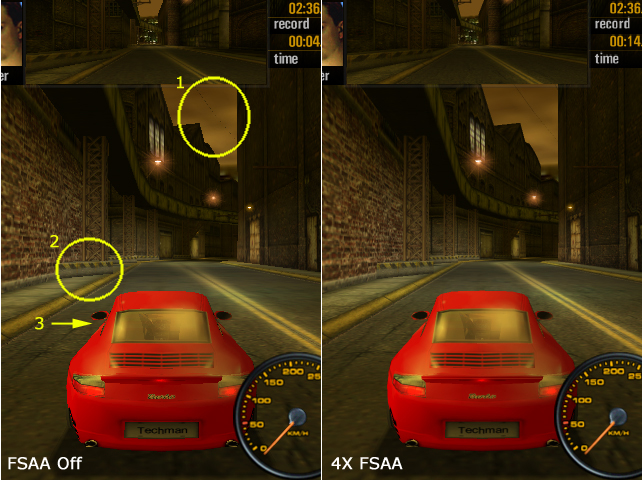FSAA & Image Quality Comparison - 3dfx vs ATI vs NVIDIA
by Anand Lal Shimpi on July 27, 2000 3:11 AM EST- Posted in
- GPUs
ATI
The Radeon is probably the easiest card to test when it comes to FSAA image quality and performance since it only supports one setting, what they like to call "4X FSAA."
The Radeon's FSAA works using a method called "supersampling," which happens to be the same method NVIDIA uses in their FSAA implementation. This method of FSAA basically takes the current game resolution and multiplies the horizontal and vertical resolutions by a factor, renders the scene at the higher resolution, and then scales the scene back down to the game resolution.
In the Radeon's case, its "4X FSAA" is really a 4 Sample FSAA since it multiplies the horizontal and vertical resolutions by a factor of two, renders the scene and then scales it down to the game resolution before displaying it. For example, enabling FSAA at 640 x 480 would mean that the current frame is actually rendered at 1280 x 960 and then scaled back down to 640 x 480. This means that the Radeon has to render 4 times as many pixels, effectively making the Radeon's 4X FSAA a 4 Sample FSAA and thus deserving of a direct comparison to 3dfx's 4 Sample FSAA.
Unfortunately, because the Radeon only has one FSAA setting, that being a 4 Sample setting, enabling FSAA on the Radeon isn't a viable option in many cases since the performance hit is so great. The Radeon basically drops to 1/4 of its theoretical fill rate when its FSAA is enabled, which may be alright in a situation that isn't fill rate limited or where 60+ fps frame rates aren't absolutely necessary, but it certainly isn't acceptable for all games.
|
Fill Rate Comparison
|
|||
|
FSAA
Disabled
|
2
Sample FSAA
|
4
Sample FSAA
|
|
| ATI Radeon 64DDR |
366
MPixels/s
1.1 GTexels/s |
91.5
MPixels/s
275 MTexels/s |
|
| 3dfx Voodoo3 3500 |
183 MPixels/s
366 MTexels/s |
||
| NVIDIA TNT2 Ultra |
300
MPixels/s
300 MTexels/s |
||
The Radeon's fill rate is an interesting topic of discussion since it has two rendering pipelines but can process three textures per pipeline. In single textured games, the Radeon's fill rate takes a dive as it drops down to the level of a Voodoo2 when 4 sample FSAA is enabled. And since most current games only make use of two textures, the 1.1 GTexels/s fill rate drops down to 733 MTexels/s since the former theoretical figure is taken assuming that we are rendering in a three texture per pixel environment.
Once again, these are theoretical numbers illustrating raw fill rate; with the Radeon you also have to take into account the effects of its HyperZ on available fill rate as well.
Below we have a comparison of the Radeon without FSAA and with its 4 Sample setting enabled.

Just as with the Voodoo5, enabling the 4 Sample FSAA on the Radeon helps to 1) make the powerline continuous, 2) smoothen out the 'jaggies' along the lower part of the bridge and 3) smoothen out the 'jaggies' on the car itself.










0 Comments
View All Comments